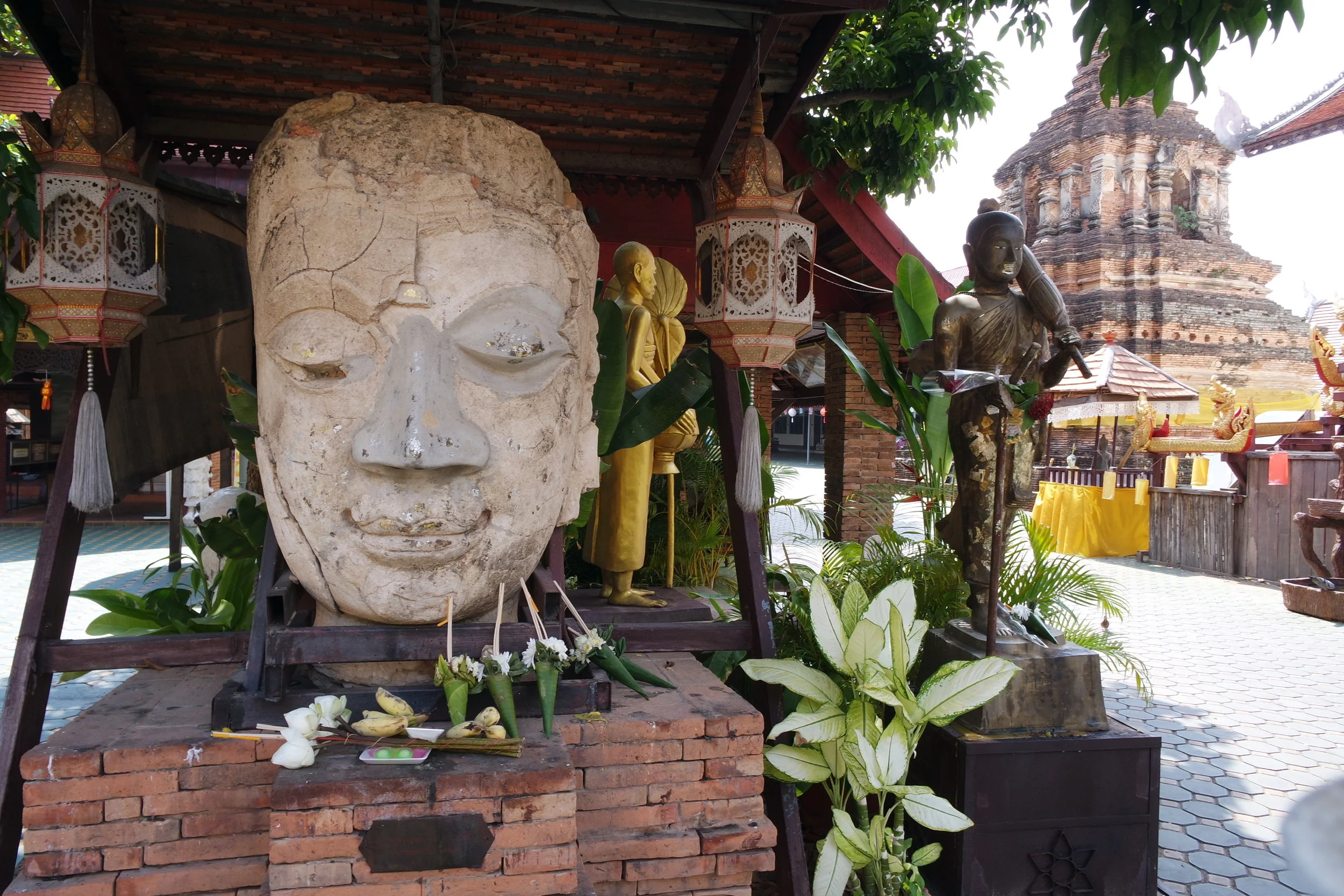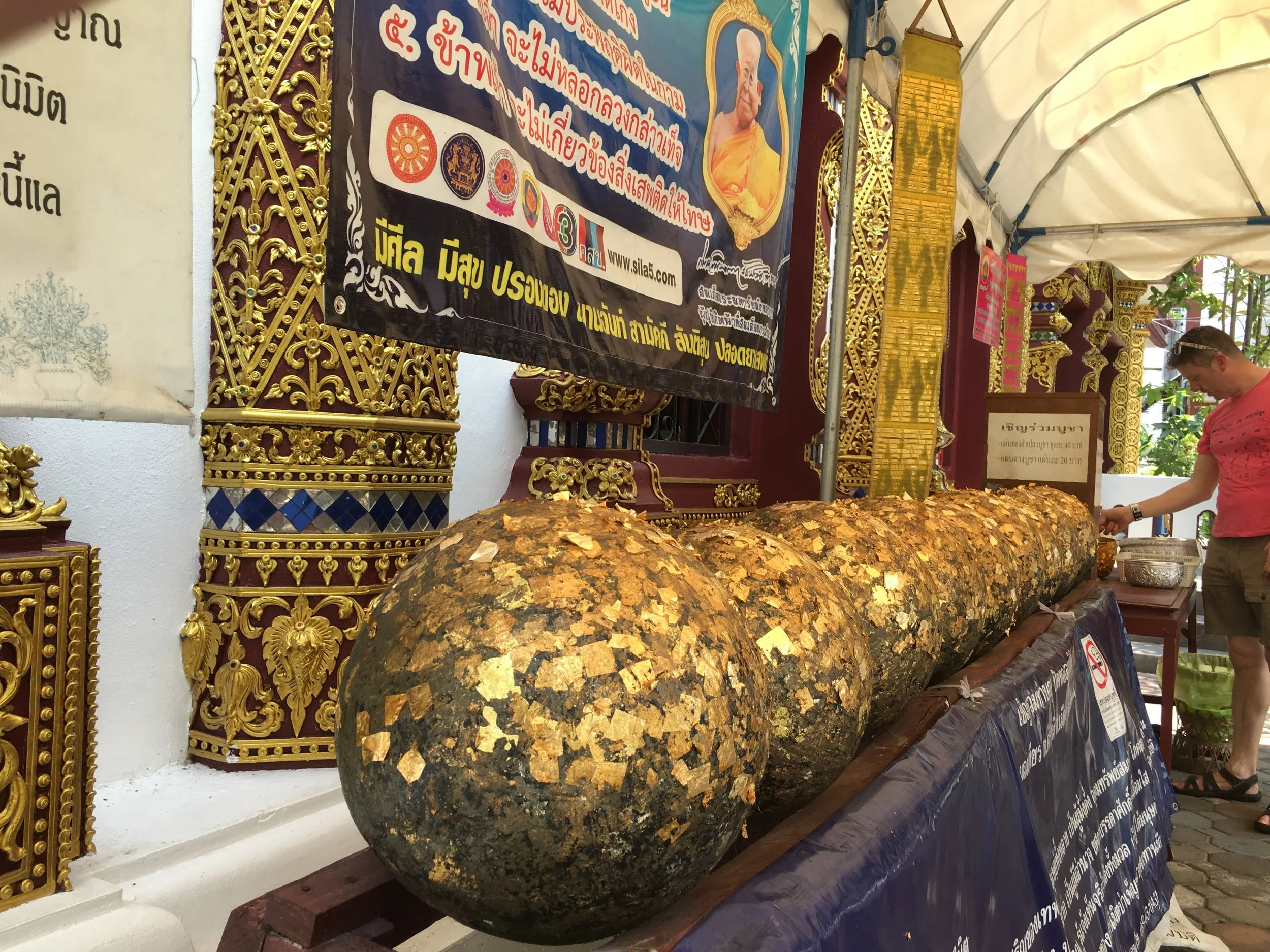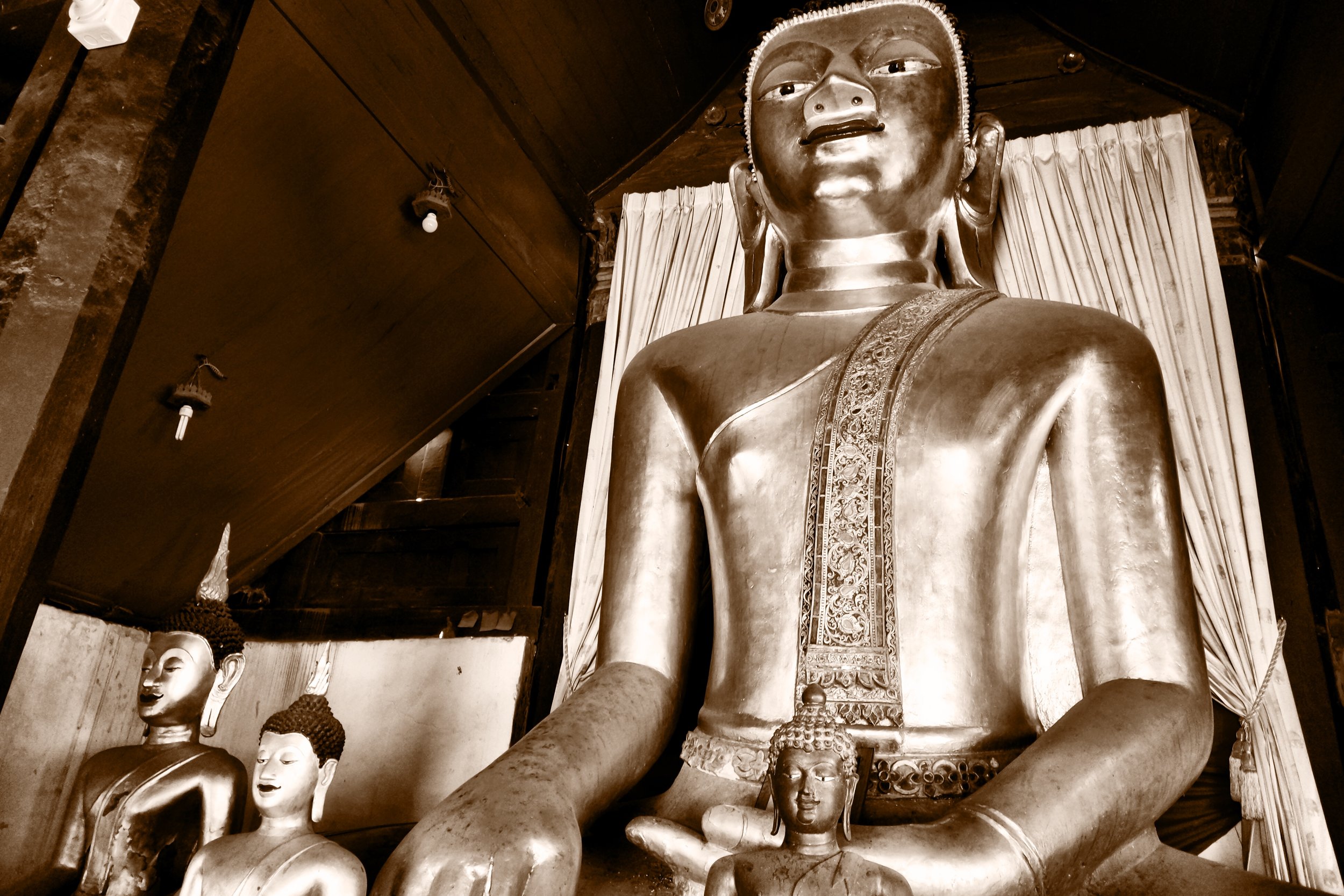There’s no shortage of things to do in Chiang Mai. Spend a day visiting some of the lesser-known wats.
With literally hundreds of ancient and beautiful temples (known as wats) to choose from it’s easy to become overwhelmed when trying to decide which to visit when staying in Chiang Mai, Thailand. The city’s history is a melting pot of cultures which are reflected in the architectural influences from outside the region, including Sri Lanka, Burma, China and Laos. Here’s our guide to four hidden gems you might miss unless you know where to look.
A giant Buddha head greets visitors to Wat Jetlin
Wat Jetlin (aka Jedlin, Chedlin)
While this temple is not exactly a major tourist destination, it does contain a few quirky elements worth seeing.
Just inside the entrance a massive stone Buddha head greeted us. The courtyard includes a bizarre five-eyed panda-like creature that eats hot coals and poops out gold, as well as an open-air pavilion with a seated skeleton sporting a pair of black sunglasses and a colorful dashiki shirt. We saw a variation of the coal-eating creature at Wat Sang Kaew, just outside of Chiang Rai.
Say hi to the dapper skeleton at Wat Jetlin
This mutated beast eats coals and defecates gold!
The interior of the Lanna-style viharn contains red lacquered columns and a large golden Buddha seated in the Bhumisparsha mudra, or Earth witness position, a gesture that symbolizes the Buddha’s enlightenment under the sacred bodhi tree. King Mekuthi, the 18th monarch of the Mangrai dynasty, was coronated here.
Most chedi throughout the province are clad in copper, brass plate or white plaster. The chedi of Wat Jetlin is in its original state: lime mortar and red clay bricks. Halfway up the four sides of the chedi are niches containing Buddha images.
Walk past the chedi until you reach a narrow covered bridge that leads across a pond where humongous lily pads float. The gaping maws of giant carp break the mirrored surface to slurp insects and the food pellets we purchased.
Address: 6 Salan Road, Soi 7
The prettiest part of Wat Ket Karam is the metallic mosaic on the back of the viharn
Wat Ket Karam
Situated on the east bank of the Mae Ping river outside of the Old City, the Wat Ket district was provided as an enclave for foreigners, many of whom were involved in the teak trade and were required by law to live there. The center was on Charoenrat Road, which was also one of the largest Chinese communities outside of China.
The 15th century compound of Wat Ket Karam is dedicated to those born in the Thai Year of the Dog. You’ll see an assortment of dog figurines throughout the grounds, bordering on kitsch.
Wally wants a pet naga
The entrance of the viharn is guarded by a pair of colossal glass-inlaid naga-makaras (sea monsters disgorging snakelike dragons sprouting antler tines from their heads). Multiple roof tiers give the structure the illusion that there are five prayer halls in succession instead of just one.
The ubosot at Ket Karam wasn’t open when we visited, but the exterior is beautiful
At the side of the viharn is the former abbot’s residence, which was converted into a museum by Jack Bain, son of William Bain, the last managing director of the East Borneo Trading Company. Walls and shelves are filled with ancient farm tools, pottery, antique drums and period clothing, some of which belonged to Chiang Mai royalty. We visited several times, peeking into the dusty, cluttered space, but the museum was never open.
The entire complex of Wat Ket Karam is gorgeous and fun to explore
The compound contains an impressive large, squat, whitewashed chedi, Ket Kaew Chura Manee, erected in 1428 to house a relic of the Buddha’s hair (funny, we thought he had a shaved head). According to a plaque, the spire of the pagoda is purposely tilted “to avoid indecency in pointing it to the one in heaven.” The chedi is guarded by four chinthe, Shan leonine creatures related to the Thai singh.
Address: Chang Moi, Mueng Chiang Mai District
There’s not a lot to see at Wat Kuan Kama, aside from the line of horses on the wall enclosure
Wat Kuan Kama
Located on Sriphoom Road, a few blocks from the Chang Phuak Gate is Wat Kuan Kama. You can’t really miss this temple due to the golden horse statues that run the entire length of its outer walls — although our tuk-tuk driver dropped us off a couple blocks away.
The temple was commissioned by a royal soldier in 1492 and dedicated to memorialize his most beloved horse. A plaque inside reads, “This temple was the garden of the horse groom who was a close royal soldier of Jaomundamtuang. After his horse died, he was very sad and he decided to donate his garden for the temple and he gave the temple the name Khunkama.”
On the inside of the walled enclosure are golden statues symbolizing the 12 animals of the zodiac.
Address: 242/6 Manee Nopparat Road
Wat Rajamontean is nicknamed the Big Buddha Temple for obvious reasons
Wat Rajamontean
This temple, next to Wat Kuan Kama, has some serious curb appeal. Elaborate tiered red and gold mini-chedi, or stupika, emerge from its exterior wall. Climb the steps to get a closer look at the giant seated Buddha overlooking the street below. Two fierce-looking bug-eyed dragons stand guard outside the viharn.
We had left our sandals at the viharn entrance and scampered quickly across the tiled surface, which gets quite hot in the midday sun. The viharn itself, with its gold details, is quite impressive.
These balls, known as luk nimit, are usually buried under an image of the Buddha
To the side of the viharn were nine luk nimit, consecrated spherical stones. These are rarely seen as they are typically buried beneath sima, leaf-shaped boundary marker stones, placed at the four cardinal points, the center of each wall and beneath the principal Buddha image of an ubosot. When a new ubosot is to be constructed, temples often put up huge banners, offering the faithful the opportunity to gain merit by contributing money and precious objects, including Buddha images and amulets to bury with the luk nimit. These were covered with gold leaf offerings by those seeking to gain kharmic bonus points.
Address: Si Phum
The beautiful whitewashed chedi at Wat Saen Fang is surrounded by gold umbrellas and offeratory fires
Wat Saen Fang
Slip past a pair of tall red-painted cast iron gates and into the naga-lined passage off Tha Phae Road, and you’ll find yourself entering the peaceful 14th century compound of Wat Saen Fang.
Figurines of mythological guardian spirits known as kinaree, mythical half-bird, half human creatures, adorn the hipped roof of the ordination hall.
The original chedi was renovated during the Burmese occupation of Chiang Mai. Its whitewashed bell-shaped body is embellished with dazzling colored-glass mosaic and topped with a golden hti umbrella. As if this wasn’t stimulating enough, over 40 stupika sit atop the low wall surrounding the pedestal base.
The intricately carved and gilded panels of the viharn pediment are painted in brilliant red and gold. The structure was the former ho kham, the royal residence of Chao Kawilorot, the sixth prince of Chiang Mai. It was moved to the temple grounds in 1878 and converted into a viharn by his successor, Inthawichayanon.
During the ceremony of sai sin, people loop strings around each other’s heads
A blessing ceremony known as sai sin was taking place as we explored the temple grounds. A sacred white cotton thread that has been blessed was being looped around the heads of the attendees. Because the thread connects the individuals, it’s believed to help reach enlightenment and form an unbroken line of protective power. –Duke
Address: 164 Thapae Road, Soi 3









































